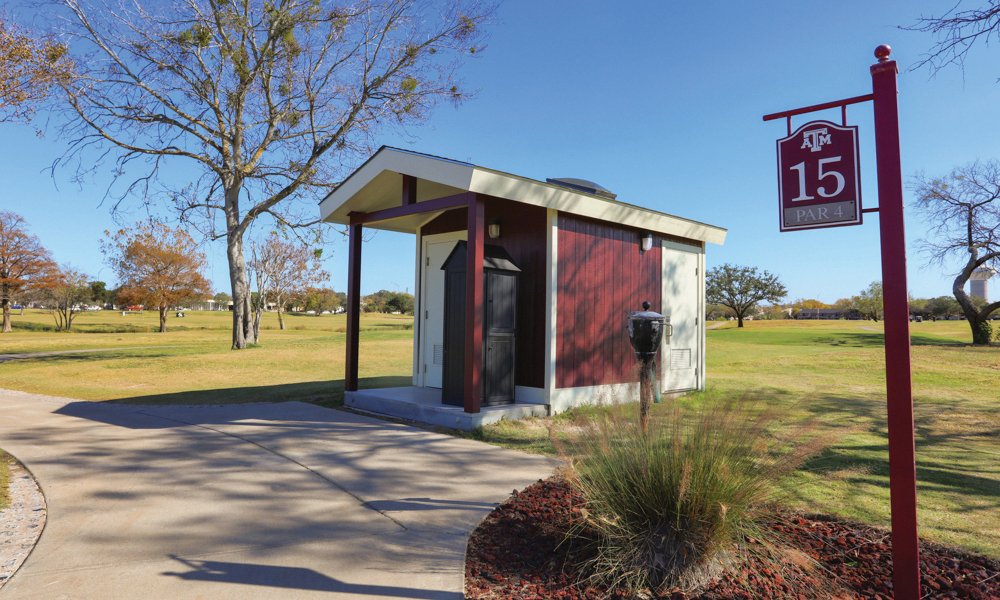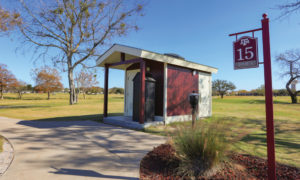Getting the right restroom for your golf course doesn’t have to be a major chore – or a major bore. It can be as simple as putting a small waterless facility beside the ninth hole. On the other hand, adding a restroom building can be a great way to meet multiple goals, such as getting a concession stand or maintenance room on your course.
There are several questions golf course superintendents should ask themselves when considering new restrooms. Once they have the answers, they can begin thinking about the best course of action for getting that restroom built.
Where will my utilities come from?
“The first thing to consider is if you have water and other facilities on the golf course,” says David Smith, a project manager with Romtec, Inc., which specializes in prefabricated and pre-engineered restroom buildings.
William C. Kempf, a Santa Cruz architect who has designed restrooms for two California golf courses, agrees. “The thing that makes golf course restrooms so different is that you have them out in the middle of nowhere,” he says. “Getting the utilities to them is really difficult.”
Kempf points out that it may be possible to tie into the irrigation system for water. But, he says, “Getting the sewage out is really hard. You’re left with the option of doing a drop-in septic tank or a whole septic tank.”
Finding power for lighting, hand dryers and other equipment can also be tough. If electricity is not immediately available, both Smith and Kempf recommend looking into solar panels so the building can be self-sustaining.
Related: The subtle necessity of on golf course restrooms
What type of restroom do I need?
There are three main types of restrooms. Waterless restrooms feature pit toilets and handwashing sinks. This is a simple, low-cost option that may be especially appealing to courses with limited budgets or those where utilities are not readily available.
Smith shares a great tip for waterless restrooms: build them so that plumbing can be added later with minimal retrofitting if needed. Also, he says, make sure you work with someone who understands how ventilation and prevailing winds can be used to help odors dissipate.
Plumbed restrooms, as the name implies, contain flush toilets and sinks with running water. Once water is available at the site, these buildings can also provide other basic necessities such as drinking fountains.
A restroom can also be much more than a collection of toilets and sinks. Depending on the course’s needs, a restroom can actually act as a multi-purpose facility. Adding a concession stand or sales area can be a new source of revenue, Kempf points out. Including maintenance, the room can mean hauling mowers and other equipment shorter distances.
Think creatively about other things that would benefit the course, Smith says. “Romtec has used extra spaces within a restroom building for security equipment, controls for irrigation systems, and other things to meet our clients’ needs.”
Golf course superintendents should consider whether the restrooms need to comply with ADA or other requirements, Smith notes. Also, they should decide early on whether the restrooms will have private, unisex rooms or separate men’s and women’s facilities.
What should the building look like?
Perhaps your golf course has a clubhouse with a signature look, or it adheres to a certain theme with all its buildings. Another important question to answer at the very beginning of your design process, Smith says, is “How do you want your restroom to blend into the course?”
Whatever your decision, it’s vital to construct the building from durable materials, Kempf says. “That’s the thing we always discuss: how are we going to be able to maintain it and clean it.” This may be less of an issue on private courses, but for public golf courses with restrooms near the park entrance, graffiti and other forms of vandalism can be a major concern in the long run.
Kempf feels that stick-built restrooms are not the way to go in most cases. “The best way to build these things is out of the concrete block, brick, or materials that can stand up to just about anything.”
How can I get the restroom I want at the best price?
Hiring an architect and contractor is one route to getting a brand-new golf course restroom building. This ensures the building has the exact layout and features you want. It’s a good idea to work with an architect like Kempf who has experience designing restrooms and working with your type of course (either privately or publically owned).
In most cases, it is more affordable and convenient to purchase a complete restroom building from a design-build company like Romtec. They offer “prefabricated” buildings that are assembled and delivered in two pieces for simple installation. They also have “pre-engineered” structures. These come in packages “similar to a Lego kit,” Smith says. The construction work can be done by the golf course’s maintenance crew, a local contractor, or through Romtec.
Romtec offers dozens of plans for CMU-block restrooms that can be customized to give the building any look or feel the golf course wants. After that, “we provide the engineering services and all the documents you need to go to your local building department,” Smith says. This makes the process of getting the building approved quite simple.
However you decide to get a new restroom on your course, players will thank you for providing them with a clean, high-quality facility.
Sophia Bennett is a freelance writer based in Eugene, Oregon. Her work has appeared in over a dozen publications including Club & Resort Business, Wine Business Monthly, Resource Recycling and Acres USA.























